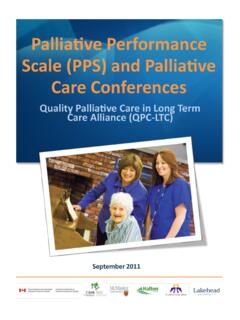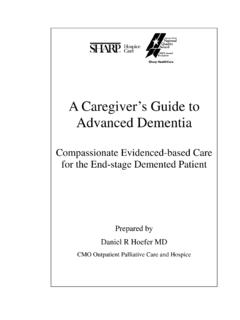Transcription of SAGE Open “Death Is Part of the Job” in Long-Term …
1 SAGE OpenJanuary-March 2015: 1 15 The Author(s) 2015 DOI: Commons CC BY: This article is distributed under the terms of the Creative Commons Attribution License ( ) which permits any use, reproduction and distribution of the work without further permission provided the original work is attributed as specified on the SAGE and Open Access page ( ).ArticleIntroductionFor registered nurses (RNs) and personal support workers (PSWs; also known as health care aides or nursing assistants) who work directly with residents in Long-Term care (LTC) homes, death, dying, and grief are usual experiences in their day-to-day working life (Anderson & Gaugler, 2007; Wowchuck, McClement & Bond 2007).
2 LTC homes increas-ingly provide end-of-life care , with approximately 20% of residents in Canada dying each year (Canadian Institute for Health Information, 2012; Statistics Canada, 2011; Travis et al., 2002). Similar trends exist in England, United States, and Australia (Froggatt et al., 2013; Parker, 2013).It is estimated that by 2020, this number will reach up to 39% in Canada (Fisher, Ross, & MacLean, 2000). Thus, it should be anticipated that staff working in LTC settings will increasingly care for dying residents on a daily basis. However, these staff who provide direct care and assistance to residents and their families are often overlooked when it comes to recognizing their own grief and bereavement expe-riences.
3 At the health system level, LTC homes have only recently been recognized as a major location of death, and therefore an important setting for providing palliative and end-of-life care (Hirdes, Mitchell, Maxwell, & White, 2011).Palliative/end-of-life care literature identifies that special-ized training, skills, and education requirements are needed for the delivery of palliative care (Froggatt, 2001; Hall, Kolliakou, Petkova, Froggatt, & Higginson, 2011; Kagan & Stricker, 2010; Sanders & Swails, 2009; Stolley, 2010). Support for grief, loss, and bereavement is acknowledged to be an important component of holistic palliative care as per Canadian Hospice Palliative care Association s (2013) Model of care .
4 Research in specialized palliative care and hospice programs is abundant and clearly demonstrates the need for and benefit of addressing staff s emotional needs to improve the quality of care and staff retention (Vachon, 1995). What is not well understood are the emotional experi-ences of direct care workers working in LTC homes, espe-cially how the organization can better support staff in managing their experience of grief and loss when a resident dies (Anderson, 2008; Anderson & Ewen, 2011; Rickerson et al., 2005). The presented research begins to address this gap in study was conducted as a sub-study within a 5-year project Improving Quality of Life for People Dying in Long-Term care Homes (2009-2014), conducted by 27 OpenMarcella and Kelleyresearch-article20151 Lakehead University, Thunder Bay, Ontario, CanadaCorresponding Author:Jill Marcella, Project Manager, Centre for Education and Research on Aging and Health, Lakehead University, 955 Oliver Road, Thunder Bay, Ontario, Canada P7B 5E1.
5 E-mail: Death Is Part of the Job in Long-Term care Homes: Supporting Direct care Staff With Their Grief and BereavementJill Marcella1 and Mary Lou Kelley1 AbstractFor Long-Term care (LTC) home staff who work directly with residents, death, dying, and grief are day-to-day experiences in their working life. However, staff are often overlooked for grief and bereavement support. This exploratory research used a qualitative approach to understand LTC staff s grief and bereavement experience and to identify the perceived support needs of nurses and personal support workers who work in two faith-based non-profit care homes in Thunder Bay, Ontario, Canada.
6 Findings indicated that participants experiences are complex, shaped by the emotional impact of each loss, the cumulative burden of ongoing grief, an organizational culture in LTC where death is hidden, and the lack of organizational attention to staffs support and education needs. Eight recommendations were developed from the findings. It is hoped that this research will assist in the development of organizational policy and procedures, addressing the health and well-being of direct care workers in LTC care , nurses, personal support workers, grief, workplace wellnessby guest on May 21, 2015 Downloaded from 2 SAGE Openresearchers and 38 community organizational partners, col-lectively known as the Quality Palliative care in Long-Term care Alliance (QPC-LTC Alliance).
7 The overarching research was a participatory action research project that used a comparative case study design, with four LTC homes located in Ontario, Canada, as study sites (Kelley & McKee, 2013). The overall goal was to improve the quality of life for people who are dying in LTC homes through the develop-ment of palliative care programs, using a process of commu-nity capacity development (Brazil, Kaasalainen, McAiney, Brink, & Kelley, 2012; Kaasalainen, Brazil, & Kelley, 2012; Ramsbottom & Kelley, 2014; Wickson-Griffiths et al., 2014; see for further information).
8 Results of the organizational assessments, conducted in 2009 in the four LTC home study sites, indicated that direct care workers develop close relationships with residents and experience a tremendous sense of loss and grief when these residents die. However, there is minimal recognition and for-mal organizational response to support staff s feelings of grief and loss. Based on these assessment results, the research team decided to conduct a more focused and in-depth sub-study to better understand the inevitable grief and loss expe-rience of direct care workers in a LTC home, including their perception of how the organization can support them with these losses.
9 Recommendations emerged from these Context of LTCH istorically, LTC homes in Ontario have operated on a medi-cal model of care , with an emphasis on managing chronic conditions (Brazil, McAiney, Caron-O Brien, & Kelley, 2004). LTC has now become an extension of chronic and complex continuing care where residents are frailer, have a number of life-limiting illnesses, and choose to remain in LTC at the end of life (Brazil, Krueger, Bedard, & Kelley, 2006; Wijk & Grimby, 2008). The average age of an Ontario LTC resident on admission is 83, with 85% of residents clas-sified as requiring high levels of care , meaning they need constant supervision and assistance in performing one or more activities of daily living (Sharkey, 2008).
10 Eighty to ninety percent of direct care in LTC homes is provided by unregistered PSWs (Berta, Laporte, Zarnett, Valdmanis, & Anderson, 2006; Riggs, & Rantz 2001). These workers are responsible for multiple tasks, such as assisting in bathing, eating, and dressing; reporting changes in physi-cal symptoms; and caring for the psychosocial needs of the resident (Anderson & Gaugler, 2007). Their workload is heavy, the resident-to- care worker ratio is high, and there is a great attention focused on the completion of care tasks (Anderson, 2008; Sharkey, 2008). In addition, LTC homes are being required to take on a prominent role in end-of-life care (McClement, Wowchuk, & Klassen, 2009) and thus are assuming many hospice-like functions.











